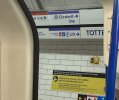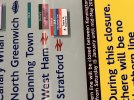Wow, it has a long way to go! getting above 50,000 would require a 21 times improvement.
Right, quite a hill to climb!
However various older articles in Modern Railways suggest that once the MTIN has passed 15,000 then train failures no longer have a significant effect on the TOCs' Public Performance Measure.
How this rule of thumb will transfer from the normal TOC's average track usage to an intensive underground network I really don't know. But my gut feeling tells me that there ought not to be more than a couple of TINs per day for the whole fleet as a three minute (or longer) delay in a service with potentially a two minute headway can easily throw out the whole service[1].
This, I am sure, is the background to Mark Wild's statements that reliability is not where he would like it to be. I would suggest that for the start of the service through the core tunnels with five minute headways he is probably looking for no more than three TINs per day and preferably lower. Two per day would translate to 56 for the whole fleet per four week period giving a value for MTIN of just under 5,000. Judging by the figures quoted in my earlier post this looks to be achievable as it would require a reliability growth of a third between the beginning of March and the opening of the Paddington - Abbey Wood section. If this is towards the end of May then an improvement of MTIN of around 10% per month might just about do it - and this section has no signalling changeovers so is a bit 'simpler'. The Easter software update will, I am sure, have helped in this respect but as yet no data are publicly available.
This analysis is, of course, simplified, as some TINs will occur between Paddington and Reading and Liverpool Street and Shenfield but the type of failure occurring on these stretches may not be applicable to the Paddington - Abbey Wood section.
Depending on the scale of the improvements gained through the Easter software updates the opening may be sooner rather than later; but the later the opening, the more reliable the service is likely to be. A difficult call!
[1] Of course the other side of the coin is the length of time that is needed to recover from each incident. If it takes five minutes (say) to reboot the train's computers then the service will be disrupted for at least ten minutes (3 mins for the TIN, plus a couple of minutes for fault finding and 'phoning a friend' and five minutes to go through the reboot process). For an intensively used underground railway this length of delay is, I suggest, unacceptable.



